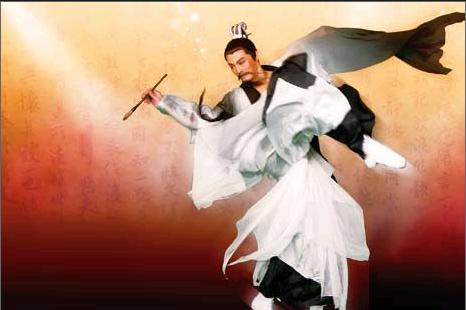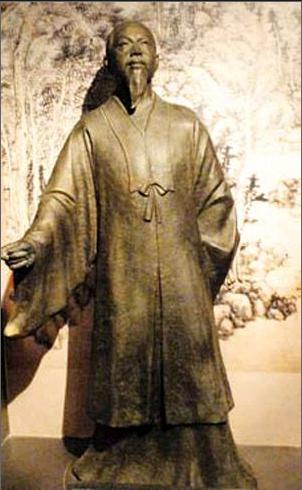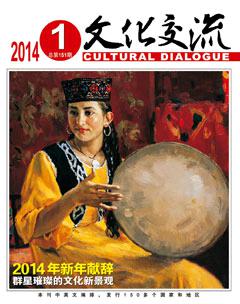一代书圣龙飞凤舞
栗子



知名舞蹈家刘福洋手执湖笔,舞步行云流水,把王羲之书法艺术的璀璨成就与仕途的黯淡落寞平行错位展示,独具风韵。
Liu Fuyang, a top-notch dancer, romanticizes Wang Xizhi as a passionate calligrapher and a failed government official.
2013年12月4日,浙江歌舞剧院用舞蹈的语言首次将书圣王羲之的一生搬上了舞台。当晚,杭州大剧院星光璀璨,热情的观众竞相见证“舞剧发展的里程碑式作品” —大型原创舞剧《王羲之》。
精彩纷呈的舞剧《王羲之》展现东方文人的独特风韵
许多人都会用“龙飞凤舞”来形容优秀的书法作品,而观看舞剧《王羲之》也让人情不自禁想到这个词。
舞剧《王羲之》分八幕,全长两个半小时,它以王羲之 “人生之景”照应“家国命运之景”,以“生活之悟”照应“中华书法之悟”,在大开大阖的剧情延展和追根探源的书法语言中,勾勒出一代书圣王羲之的血肉形象和魏晋风度,并由此折射中华书法文化和人文精神的洋洋大观。像主人公少年时向女书法家卫夫人学习书法、青年时袒腹东床被太尉郗鉴招为佳婿、中年仕途失意书艺飞跃等重要的历史情节,都得到了艺术化的再现。
大幕拉开,灯光定格 —舞台中央,知名舞蹈家刘福洋一袭黑衣,舞步如行云流水。
暮春之时,曲水流觞,书圣王羲之从遥远的兰亭向我们走来,长发、白须、仙袍,伴随清风翩翩起舞,泼墨如注,天人浑然合一。在一个多小时的时空里,舞台上衣袂翻飞,一段又一段舞蹈,书法之美与舞蹈之美交相辉映。
在中国书法史和舞蹈史上有一段佳话:唐代“草圣”张旭观看公孙大娘剑器舞后,草书功力大增。浙江歌舞剧院副院长严圣民表示,创作这部作品也是考虑到书法语言与舞蹈语言的共通点。
《王羲之》侧重于人物塑造,讲述了为什么偏偏是王羲之这个人,成为了“一代书圣”。但团队在创作此剧时,翻遍《晋书》,能找到的关于王羲之本人的描写只有寥寥几句话。总导演苏时进说,这
真是给创作团队出了个大难题:“王羲之既没有特别跌宕起伏的爱情故事,也没有牵扯进波澜壮阔的权力斗争,而舞剧又是特别需要戏剧性冲突的。”
怎么办呢?最后想出的办法是:把王羲之书法艺术的璀璨成就与仕途的黯淡落寞结合起来,在舞台上平行错位展示。该剧创意地将王羲之心灵变化和中华书法发展两者历程进行了巧构和融汇,从而勾勒王羲之的心灵境界,展现东方文人的古典风骨。
舞蹈,取书法之形韵,抒现实之情怀。音乐,集传统元素,融当代音乐。剧中的63名演员换了将近500套衣服。除特定的演员外,所有舞者的服饰都采用黑白两色,与舞美创意上追求纯粹黑白的创作手法相协调。简约,可以让观众看得更真切。
《王羲之》在舞美上追求了纯粹黑白,并用镜面地胶折射舞姿,从而展示人物内心的多层次,就连与之互动的视频设计也采用中国传统书法的墨色和传统绘画语汇的留白。苏时进表示,通过写实的舞蹈场景、视频的大写意,两者互动,舞台的正常节奏和视频的美学节奏,让人心理视觉空间放大、夸张、写意。
这是一部承载着浙江歌舞剧院50多年创优创新精神的舞剧,这是一台被浙江省委宣传部列入2013年浙江省文化艺术精品扶持工程的精品。《王羲之》的创作历时两年时间。
为了将这部舞剧打造成真正的精品,浙江歌舞剧院倾注了极大的心血。在浙江歌舞剧院二楼排练大厅经常能看到,63名身着练功服的男女演员,有的打着绑带、涂着膏药,一遍又一遍地旋转、飞跃,对每一个动作都精打细磨,才有了首演的舞台精彩。
《王羲之》最大的看点是集观赏性和技巧性于一体的舞蹈编排。翻、旋、转、跳 —王羲之扮演者刘福洋在剧中时时要完成这一系列动作的无缝衔接。有时候单单一幕舞蹈表演,刘福洋就运用了十几个技巧。就“旋转”这一技巧来说,专业芭蕾舞者旋转的次数一般最多只能达到八九次,而主演刘福洋用自己的“独门绝技”能够旋转二十多次。
出演一介书法传奇人物,让即便是拥有20多部舞剧表演
大型原创舞剧《王羲之》在杭首演,图为导演和演员谢幕情景。
Dancing artists and director of the dance drama make curtain calls at the end of the debut on the evening of December 4, 2013.
剧中王羲之和夫人(朱洁静饰演)共舞。
The duet dance displays the love of Wang Xizhi and his wife (acted by Zhu Jiejing).
经验,曾多次获国家级大奖,被誉为“中国舞剧男一号”的刘福洋也深感压力山大。“那就是一个光环一样的存在,舞剧要表现的则是一个有血有肉的人,不单单是书圣的名字,首先要了解魏晋时期的各种背景,特别是王羲之作为一个文人,气度要符合那个时代的儒雅。 ”刘福洋透露,先前他为此剧下足了工夫进行采风和历史研究。事实上,该剧也是刘福洋作为浙江省文化厅首批省属舞台艺术“拔尖人才”的新的艺术成果展示。
5年前浙江歌舞剧院曾推出一部舞剧《李叔同》,不仅让浙歌惊艳中国舞坛,而且还促成了当时还是东方歌舞团演员的刘福洋与浙歌的缘分。就是因为喜欢浙歌的工作氛围,刘福洋最长的4分钟,短则1分钟。导演苏时进用鱼和水来形容两人的合作,“只要对方一动,另一方立刻主动贴上;这边一个眼神,那边马上就对上了。 ”高难度和极具挑战性的动作,在两位青年舞蹈家的默契中得到了完美的诠释。
“舞剧《王羲之》很棒很棒,那个朝代,心向往之;那个舞台,心向往之。 ”当看完浙江歌舞剧院舞剧《王羲之》的彩排之后,有网友忍不住在微信朋友圈发出如此感慨。
浙江歌舞剧院院长董兰兴表示,真正的精品必然是有生命力的,好比《茶花女》,演了这么多年,人们依然争相观赏。“浙歌对《王羲之》的定位不是排个剧拿个奖就算了,我们的目标是做出最精最好的舞剧。 ”正如该剧编剧、中国舞蹈家协会秘书长罗斌所评论:“我看到了一艘艺术航母的启航:此剧所追求的艺术风格将会成为古典和现代间的桥梁,并将成为未来舞剧发展的里程碑式作品。 ”□
Dance Drama Dedicated to Chinas Master Calligrapher
By Li Zi
On December 4, 2013, Zhejiang Song and Dance Troupe staged the dramatized life of Wang Xizhi (321-379), widely celebrated as one of the greatest of Chinese calligraphers, at Hangzhou Grand Theater. Local audience was fortunate to witness a milestone in the history of dance dramas in China.
The 8-act, 2.5-hour-long dance drama, simply named as Wang Xizhi, portrays the masters life and art and explores what he experienced as a
government official and how he grew up to be a calligrapher. “Flying dragons and dancing phoenixes” is one of the metaphors
Chinese people use to laud the wonders of a calligraphy artwork. The vivid images convey the splendor, elegance, and dynamics of words written in ink and with a brush pen. Many who have seen the drama dance are willing to use the metaphor to describe their im-pression of the performance.
左图为精彩的舞蹈首次将书圣王羲之的一生在舞台上尽情演绎。
The dance drama interprets the life and art of the master calligra-pher for the first time in the history of China.
右图为曾多次获国家级大奖的刘福洋为此剧做足了功夫,光“旋转”这一技巧,刘福洋用自己的“独门绝技”能转20多次。
Liu Fuyang performs his unique pirouettes, displaying the beauty and charm of dance and calligra-phy in the dance drama.
Liu Fuyang, a dancer of national renown who characterizes the master on the stage, shows “flying
dragons and dancing phoenixes” aptly defines both calligraphy and dance.
And the show at the grand theater was certainly not the first time calligraphy and dance came together. Back to the Tang Dynasty (618-907), calligrapher Zhang Xu famed for his cursive style felt his calligraphy improved dramatically after watching a woman dancer did a sword stunt. Yan Shenghua, vice director of Zhejiang Song and Dance Troupe, revealed that they considered what cal-ligraphy and dance have in common between while creating and choreographing the drama.
The dance drama tries to figure out why it was that Wang Xizhi became Chinas first hall-of-famer of calligrapher. History gives few clues about him as a man and a calligrapher. No, he was neither in any epic romance nor in any complex court infighting. There was nothing for a drama on the stage. The scriptwriter finally decided to make a man who failed to find a satisfying government career turned his creativity and passion to the art of calligraphy. The dance drama tries to show how Wangs spiritual journey helped his calligraphy.
The dance drama spares no efforts to look effective and fitting.
Music and costume are two important factors that contribute to the success. The 63 dancers change altogether nearly 500 times. Some main characters on the stage have their special costumes but the
rest appear in white and black in a sharp contrast, the quintessential
colors of Chinese calligraphy. There are video clips that accompany the dance drama. The video scenes are also designed in the style of calligraphy, displaying ink and white blank. A perfect rhythm and interaction between the stage dance and the video all give audience a visual delight.
Behind the success of the drama were efforts of two years. Re-peated rehearsals, modified choreography all contributed to the beauty and wonder of the dancing on the stage.
An audience member commented online after attending the show on the evening of December 4 that his heart went all out back to the spirit of the dynasty and his memory brought him back again and again to the dazzling dance movements of the night.
Dong Langfan, the director of Zhejiang Song and Dance Troupe, says that a mas-terpiece should be full of life and people still want to see it after many years. The troupe has ambition for the dance drama. It should be more than a gold-medal win-
ner from a competition. She says, “We
want to make it the best dance drama in
the country.”
Luo Bin, the scriptwriter of the drama and secretary-general of China Danc-
ers Association, comments: “The dance
drama pursues a style that bridges the classic and the modern. We intend it to be
a milestone for future dance dramas.”

